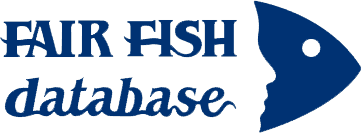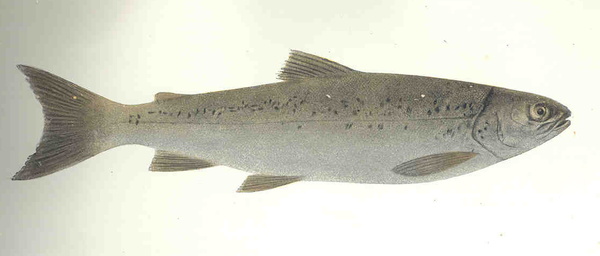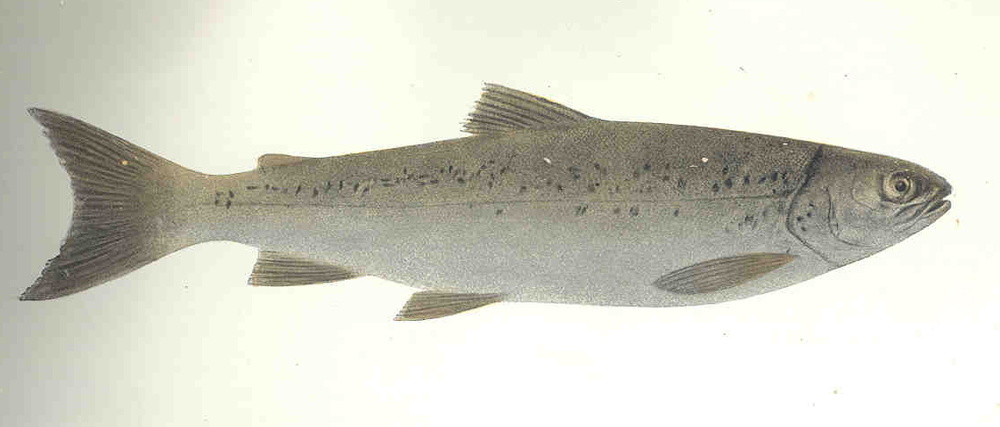Information
Version: B | 1.1 (2022-01-22)
Please note: This part of the profile is currently being revised.
WelfareScore | farm
Condensed assessment of the species' likelihood and potential for good fish welfare in aquaculture, based on ethological findings for 10 crucial criteria.
- Li = Likelihood that the individuals of the species experience good welfare under minimal farming conditions
- Po = Potential of the individuals of the species to experience good welfare under high-standard farming conditions
- Ce = Certainty of our findings in Likelihood and Potential
WelfareScore = Sum of criteria scoring "High" (max. 10)
General remarks
Salmo carpio is an Italian salmonid species restricted to Lake Garda in northern Italy, and it is currently critically endangered. Its life expectancy is 5 years. S. carpio was introduced in several Italian lakes and in New Zealand without success. An Italian Institute started a farming programme to increase the natural population and to sell them to the public. There is limited information about the behaviour and home range of S. carpio in the wild, as well as limited publicly available information about its farming conditions.
1 Home range
Many species traverse in a limited horizontal space (even if just for a certain period of time per year); the home range may be described as a species' understanding of its environment (i.e., its cognitive map) for the most important resources it needs access to.
What is the probability of providing the species' whole home range in captivity?
It is unclear for minimal and high-standard farming conditions. Our conclusion is based on a low amount of evidence.


2 Depth range
Given the availability of resources (food, shelter) or the need to avoid predators, species spend their time within a certain depth range.
What is the probability of providing the species' whole depth range in captivity?
It is unclear for minimal and high-standard farming conditions. Our conclusion is based on a low amount of evidence.


3 Migration
Some species undergo seasonal changes of environments for different purposes (feeding, spawning, etc.), and to move there, they migrate for more or less extensive distances.
What is the probability of providing farming conditions that are compatible with the migrating or habitat-changing behaviour of the species?
It is low for minimal farming conditions. It is medium for high-standard farming conditions. Our conclusion is based on a low amount of evidence.


4 Reproduction
A species reproduces at a certain age, season, and sex ratio and possibly involving courtship rituals.
What is the probability of the species reproducing naturally in captivity without manipulation of theses circumstances?
It is low for minimal and high-standard farming conditions. Our conclusion is based on a low amount of evidence.


5 Aggregation
Species differ in the way they co-exist with conspecifics or other species from being solitary to aggregating unstructured, casually roaming in shoals or closely coordinating in schools of varying densities.
What is the probability of providing farming conditions that are compatible with the aggregation behaviour of the species?
It is unclear for minimal and high-standard farming conditions. Our conclusion is based on a low amount of evidence.


6 Aggression
There is a range of adverse reactions in species, spanning from being relatively indifferent towards others to defending valuable resources (e.g., food, territory, mates) to actively attacking opponents.
What is the probability of the species being non-aggressive and non-territorial in captivity?
There are no findings for minimal and high-standard farming conditions.


7 Substrate
Depending on where in the water column the species lives, it differs in interacting with or relying on various substrates for feeding or covering purposes (e.g., plants, rocks and stones, sand and mud, turbidity).
What is the probability of providing the species' substrate and shelter needs in captivity?
It is unclear for minimal and high-standard farming conditions. Our conclusion is based on a low amount of evidence.


8 Stress
Farming involves subjecting the species to diverse procedures (e.g., handling, air exposure, short-term confinement, short-term crowding, transport), sudden parameter changes or repeated disturbances (e.g., husbandry, size-grading).
What is the probability of the species not being stressed?
There are no findings for minimal and high-standard farming conditions.


9 Malformations
Deformities that – in contrast to diseases – are commonly irreversible may indicate sub-optimal rearing conditions (e.g., mechanical stress during hatching and rearing, environmental factors unless mentioned in crit. 3, aquatic pollutants, nutritional deficiencies) or a general incompatibility of the species with being farmed.
What is the probability of the species being malformed rarely?
It is low for minimal farming conditions. It is medium for high-standard farming conditions. Our conclusion is based on a low amount of evidence.


10 Slaughter
The cornerstone for a humane treatment is that slaughter a) immediately follows stunning (i.e., while the individual is unconscious), b) happens according to a clear and reproducible set of instructions verified under farming conditions, and c) avoids pain, suffering, and distress.
What is the probability of the species being slaughtered according to a humane slaughter protocol?
It is low for minimal farming conditions. It is medium for high-standard farming conditions. Our conclusion is based on a low amount of evidence.


Side note: Domestication
Teletchea and Fontaine introduced 5 domestication levels illustrating how far species are from having their life cycle closed in captivity without wild input, how long they have been reared in captivity, and whether breeding programmes are in place.
What is the species’ domestication level?
DOMESTICATION LEVEL 3 24, level 5 being fully domesticated.
Side note: Forage fish in the feed
450-1,000 milliard wild-caught fishes end up being processed into fish meal and fish oil each year which contributes to overfishing and represents enormous suffering. There is a broad range of feeding types within species reared in captivity.
To what degree may fish meal and fish oil based on forage fish be replaced by non-forage fishery components (e.g., poultry blood meal) or sustainable sources (e.g., soybean cake)?
All age classes: WILD: planktivorous 3 25-4 1, ADULTS also piscivorous 3. FARM: FRY fed with water collected from the lake at 70-80 m 1, no data found yet on replacement studies for all age classes.
Glossary
DOMESTICATION LEVEL 3 = entire life cycle closed in captivity with wild inputs 24
FARM = setting in farming environment or under conditions simulating farming environment in terms of size of facility or number of individuals
FINGERLINGS = early juveniles with fully developed scales and working fins, the size of a human finger; for details ➝ Findings 10.1 Ontogentic development
FRY = larvae from external feeding on, for details ➝ Findings 10.1 Ontogenetic development
JUVENILES = fully developed but immature individuals, for details ➝ Findings 10.1 Ontogenetic development
LARVAE = hatching to mouth opening, for details ➝ Findings 10.1 Ontogenetic development
PELAGIC = living independent of bottom and shore of a body of water
PHOTOPERIOD = duration of daylight
POTAMODROMOUS = migrating within fresh water
SPAWNERS = adults during the spawning season; in farms: adults that are kept as broodstock
WILD = setting in the wild
Bibliography
2 Lunelli, Fernando. 2017. L’allevamento Intensivo del Carpione: 12.
3 Melotto, S., and G. Alessio. 1990. Biology of carpione, Salmo carpio L., an endemic species of Lake Garda (Italy). Journal of Fish Biology 37: 687–698. https://doi.org/10.1111/j.1095-8649.1990.tb02533.x.
4 Lunelli, Fernando, Filippo Faccenda, Ivano Confortini, Cristina Cappelletti, and Francesca Ciutti. 2012. Salmo carpio: an Endemic Salmonid of Lake Garda, Northern Italy. World Aquaculture: 46–49.
5 Lunelli, Fernando, Filippo Faccenda, Filippo Motta, Cristina Cappelletti, and Francesca Ciutti. 2012. Rearing of carpione Salmo carpio, an endemic salmonid in Lake Garda (Italy). Archivio Istituzionale Della Ricerca. Fondazione Edmund Mach.
6 Merlo, Simonetta. 1954. Esame biometrico comparativo dei Salmo carpio a riproduzione estiva e invernale. Bolletino di zoologia 21: 157–159. https://doi.org/10.1080/11250005409438167.
7 Merlo, Simonetta. 1955. Accrescimento e ciclo vitale del « Salmo carpio » del Garda. Bolletino di zoologia 22: 265–274. https://doi.org/10.1080/11250005509439205.
8 Meraner, Andreas, and Andrea Gandolfi. 2018. Genetics of the Genus Salmo in Italy: Evolutionary History, Population Structure, Molecular Ecology and Conservation. In Brown trout: biology, ecology and management, ed. Javier Lobón-Cervía and Nuria Sanz. Hoboken, NJ: Wiley.
9 Buon agricoltura. 2020. La Riscoperta del Carpione del Garda. Italy.
10 Colombo, Stefano, Stefania Arioli, Simone Guglielmetti, Fernando Lunelli, and Diego Mora. 2016. Virome-associated antibiotic-resistance genes in an experimental aquaculture facility. Edited by Pascal Simonet. FEMS Microbiology Ecology 92: fiw003. https://doi.org/10.1093/femsec/fiw003.
11 Lunelli, Fernando. 2010. The reproductive sites of Garda Lake carpione (Salmo carpio): monitoring and conservation status. Centro Transferimento Tecnologico Rapporto 2010. San Michele all’Adige (TN): Istituto agrario di San Michele all’Adige.
12 Fairgrieve, W. 2009. Cultured Aquatic Species Information Programme. Oncorhynchus kisutch. Rome: FAO Fisheries and Aquaculture Department.
13 LocalCoho Farms. 2021. Personal communication.
14 Johnson, W S. 1984. Photoperiod Induced Delayed Maturation Of Freshwater Reared Chinook Salmon. Aquaculture 43: 279–287.
15 Robb, D H F, and S C Kestin. 2002. Methods Used to Kill Fish: Field Observations and Literature Reviewed. Animal Welfare 11: 269–282.
16 Lines, J. A., D. H. Robb, S. C. Kestin, S. C. Crook, and T. Benson. 2003. Electric stunning: a humane slaughter method for trout. Aquacultural Engineering 28: 141–154. https://doi.org/10.1016/S0144-8609(03)00021-9.
17 European Food Safety Authority (EFSA). 2009. General approach to fish welfare and to the concept of sentience in fish. EFSA Journal 7: 954. https://doi.org/https://doi.org/10.2903/j.efsa.2009.954.
18 Concollato, Anna, Rolf Erik Olsen, Sheyla Cristina Vargas, Antonio Bonelli, Marco Cullere, and Giuliana Parisi. 2016. Effects of stunning/slaughtering methods in rainbow trout (Oncorhynchus mykiss) from death until rigor mortis resolution. Aquaculture 464: 74–79. https://doi.org/10.1016/j.aquaculture.2016.06.009.
19 Robb, D. H. F., S. B. Wotton, J. L. McKinstry, N. K. Sørensen, S. C. Kestin, and N. K. Sørensen. 2000. Commercial slaughter methods used on Atlantic salmon: determination of the onset of brain failure by electroencephalography. Veterinary Record 147: 298–303. https://doi.org/10.1136/vr.147.11.298.
20 Roth, Bjorn, Erik Slinde, and David H. F. Robb. 2007. Percussive stunning of Atlantic salmon (Salmo salar) and the relation between force and stunning. Aquacultural Engineering 36: 192–197. https://doi.org/10.1016/j.aquaeng.2006.11.001.
21 European Food Safety Authority (EFSA). 2009. Species-specific welfare aspects of the main systems of stunning and killing of farmed Atlantic Salmon. EFSA Journal 7: 1–77. https://doi.org/10.2903/j.efsa.2009.1011.
22 Lambooij, E., E. Grimsbø, J. W. van de Vis, H. G. M. Reimert, R. Nortvedt, and B. Roth. 2010. Percussion and electrical stunning of Atlantic salmon (Salmo salar) after dewatering and subsequent effect on brain and heart activities. Aquaculture 300: 107–112. https://doi.org/10.1016/j.aquaculture.2009.12.022.
23 Castanheira, Maria Filipa. 2017. Personal communication.
24 Teletchea, Fabrice, and Pascal Fontaine. 2012. Levels of domestication in fish: implications for the sustainable future of aquaculture. Fish and Fisheries 15: 181–195. https://doi.org/10.1111/faf.12006.
25 Alessio, G., S. Melotto, and E. Oppi. 1990. Indagini fondamentali sulla biologia del carpione, Salmo carpio L., del lago di Garda. Rivista di Idrobiologia 29: 51–68.






